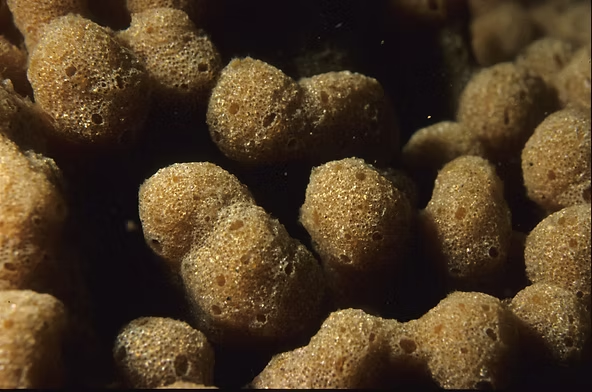Arctic Sponges and Their Fossil Feast
Deep in the ice-covered central Arctic Ocean, far from any coastline, life on the seafloor seems scarce. Core samples often yield little more than barren muck, seemingly devoid of visible organisms. Yet in 2011, scientists made a surprising discovery on an extinct submarine volcano: a large sponge. When researchers returned in 2016, they found the entire seamount summit covered with dense sponge gardens, some more than three feet across.
A Surprising Diet
In a region thought to lack food, the sponges’ survival puzzled scientists. The mystery was solved when researchers discovered that the sponges were feeding on fossilized remains of tube worms. These worms had once thrived on methane seeping from the active volcano, leaving behind chitin- and protein-rich tubes after their extinction. Symbiotic bacteria within the sponges help digest this unusual food source, making this the first known case of an animal feeding on fossils.
Hairy Hills of the Deep
Active underwater volcanoes once supported tube worm colonies that grew generation upon generation, forming what appeared to be “hairy hills.” When volcanic activity ceased, the worms died, leaving fossilized tubes. The sponges’ unique relationship with bacteria enables them to use this unexpected food supply, ensuring survival in one of the most inhospitable regions of the planet.
Origins and Reproduction
How did the sponges reach this remote seamount? Scientists suspect they arrived as drifting larvae from colonies in Norwegian waters. Once established, the sponges reproduced and spread, passing on their specialized microbiome to offspring. While sponges can reproduce sexually, budding genetically identical sponges allows for stable survival in harsh conditions. Evidence also shows that adult sponges can slowly move uphill, leaving trails of spicules as they shift to better feeding areas.
A Shelter for Other Life
The sponge gardens host small animals such as shrimps and sea stars, which feed on sponge material or leftovers from their fossil diet. This creates a miniature ecosystem in a seemingly barren landscape, turning the extinct volcano into a hub of surprising biodiversity.
Future Challenges
The sponge colonies’ survival may extend for centuries due to their extremely low metabolism and abundant fossil food. However, climate change poses a looming threat. As Arctic ice cover decreases, algae growth could increase food supply to the seafloor. While this might not harm the sponges directly, it could enable faster-growing species to outcompete them, destabilizing the ecosystem.
Why This Discovery Matters
This remarkable finding highlights how life can adapt to unexpected food sources and thrive where survival seems impossible. It also underscores how much remains unknown about deep-sea ecosystems. As researcher Autun Purser cautions, once environmental conditions shift, ecosystems may change in unpredictable ways—making continued monitoring and conservation efforts vital.

